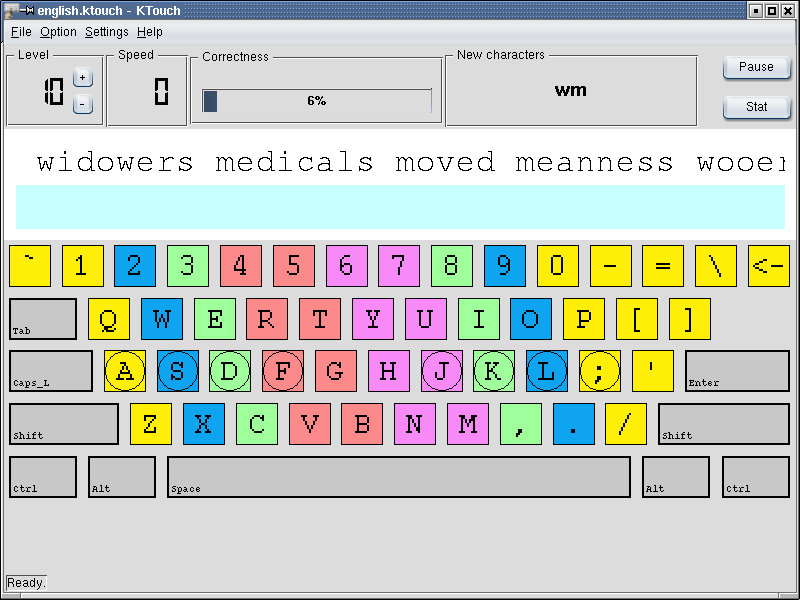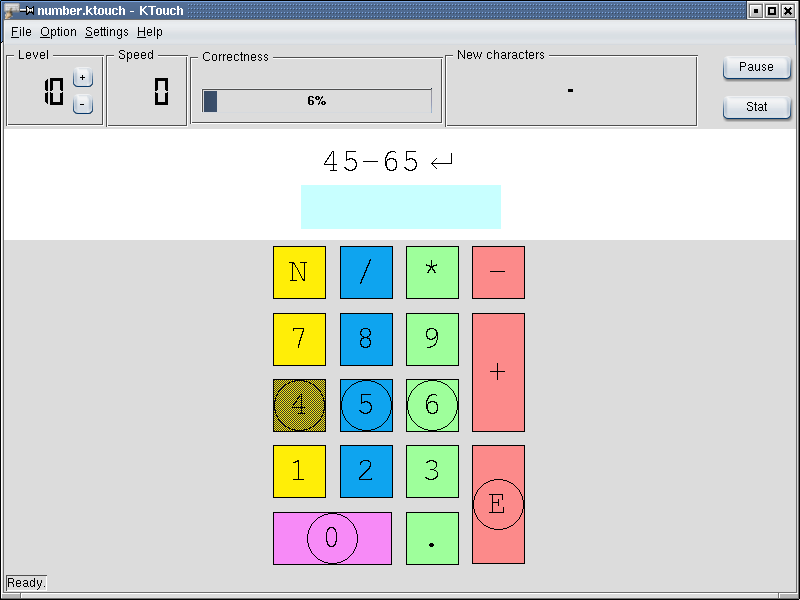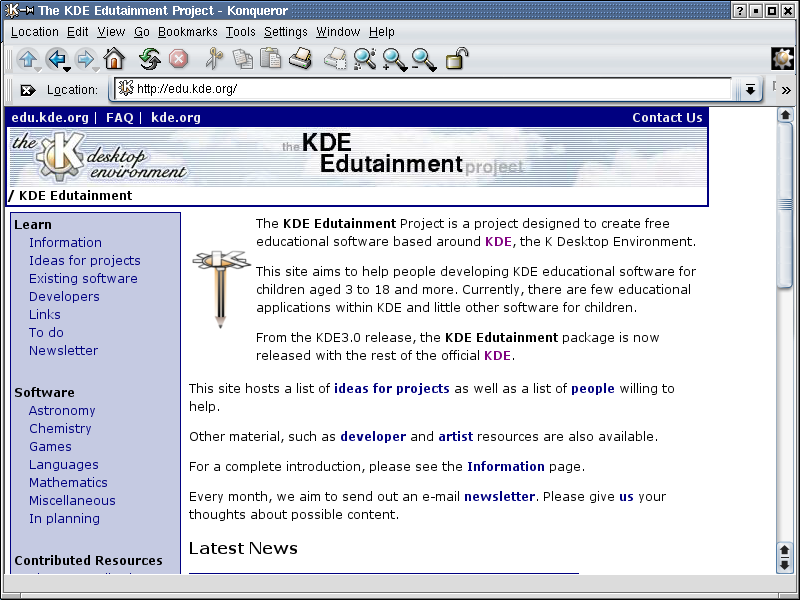TUX&GNU@school - 1st edition
This is the first of approximately 3 editions of the column "TUX&GNU@school". I will report every month about a piece of free education software, a website on the topic and an idea for an useful program for school purposes. This month I talk about KTouch [1], a KDE program for learning touch writing, edu.kde.org [2], the homepage of the KDE edutainment project and the idea "multiplication-table worksheets generated easily".
After servers, GNU/Linux and Free Software in general conquer more and more desktops too. Till recently, they lacked of two important software scopes to exist on the desktop: On the one hand these are first class computer games and on the other hand this is education software. Approximately half a year ago two colleaques and me founded the ALIS - Arbeitsgruppe Linux an Schulen (Swiss work group for linux at school) [3] whose goal it is helping schools using GNU/Linux and Free Software and help them with words and deeds. In this context I became concious that almost nobody reported about free education software and so, as a big fan of the Brave GNU World [4], from now on I want to report about free software and GNU/Linux at and for schools monthly (at the moment for the next three month til July). Depending on what's the feedback and appeal I will pursue after July. With this in mind every kind of feedback, criticism, questions and more are gladly read [5].
But now let's continue with the first piece of free education software.
KTouch - Touch typing learned easily
KTouch is a program for KDE which helps learning touch writing. It's already available in version 1.0 and was lately continued with KDEedu incorporated in KDE 3.0 [6]. I tested it under Debian GNU/Linux 3.0 (testing) with KDE 2.2 and XFree86 4.1.0.
Essentially the interface of KTouch is divided into four sections (see screenshot 1). Upmost there is the menu bar located listing the following items: File, Option Settings and Help. Right under it there is the status bar showing from left to right, on which level you practise, how many strokes a minute you make, how much percent of the already entered words or letters were correct, which new letters are introduced in the current level and quite right there is an break button disconnecting the lesson. Beneath it goes on with the doublespaced bar showing the to typing text in the first and the typed text in the second row. When you make a mistake the second row changes color into red and you see instantly that you have to erase some characters. In the last and largest sections the keyboard is drawn. This is fairly colored, large and clear. Scaling the program window up the layout is adapting itself optimally to the size of the window.

Screenshot 1: KTouch in action
Under File->Open it is easily possible to start lessons for other languages and keyboards. Already available are lessons for the languages: German, English, French and Norwegian plus a lesson for the numbers block (see screenshot 2). By the way it is very easy to write new lessons, these are saved in simple text files of course. For this purpose there is an own chapter in the documentation explaining how to do it. Furthermore you can set different keyboard layouts under Option->Keyboard of course. These are saved only in text files as well and it is relatively easy possible to add new one. General settings as the font style, color or sound are adjustable under Option->General. Some further settings for the exercise course respectively the level are manageable under Option->Training.

Screenshot 2: The number block
It's very simple to learn typewriting with this program first of all because the keys for each finger are marked with the same color. All that keys you have to push right now are also marked. But what I still missing is a description for each lesson guiding one and give one a short introduction for each new key and finger. In the interview, published perhaps one week ago, the author of KTouch says that this should be one of the next items he want to implement. Incidentally the interview arose in context with the choice to the "Anwendung des Monat" (Application of the month) on KDE.de [8], the German portal of KDE. Beyond stays to say that the next version, released with KDE 3.0, has already a statistic function making it possible to regard more on the own results with the lessons.
But now continues to the home of KTouch.
edu.kde.org - The KDE Edutainment project
The KDE Edutainment project is the gate to the world of the KDE education software. Since version 3.0 of the K Desktop Environment KDEedu is one of its standard packages. The homepage enqueues itself seamlessly in the bank of <KDE-theme>.kde.org sites. It is build very clear with a navigation bar at the left side dividing the whole, namely Learn, Software, Contributed Resources, Develop and Contact in 5 sections The page is at the moment available in English only. You will be explained right on the front page KDEedu want to develop free education software for kids and teenagers between 3 and 18 (and older) which is integrated in KDE optimally. Underneath there are listed the news, mostly a link to the monthly released newsletter which reports about how the project and the single programs are evolving.
In the second part, Learn, you principally find information about KDE education software and how you generate it most suitable and in the best way. In a second item suggestions are published giving programmers a first idea for a new piece of education software. Following hereon the already existing KDE education programs are introduced with a short description and a small screenshot. Then they list links to known and related sites on the topic and a todo section which informs what's not yet done. But this section is no longer up to date because they implemented already some of the items. The last item contains links to the newsletters you can subscribe to right there.
The second item divides the software into categories. And these are Astronomy, Chemistry, Languages, Mathematics, Miscellaneous and Plannig. Astronomy contains the very extensive program KStars which shows the nightly starry sky with some 10'000 objects and gives additional information too. The application Kalzium belongs to Chemistry offering an informative and clear presentation of the Periodic Table of the Elements. KHangMan and KMessedWords are two games which let children learn new words playfully. At the moment in the section Languages are still a lot of programs occupying with a specific language or helping you to learn expressions from another language. Here the tendency goes partly in the direction of integration of the single applications what seems to make sense. In the second last part of the already implemented programs they talk about mathematical applications as e.g. KGeo, a program for the simplified presentation and construction of geometric drawings. Further are available: KBruch, KmPlot, KMathTool, KPercentage and KTimes. Under Miscellaneous you then can find too KEduca, a programm for the generation of small tests and KTouch, a hopefully already known piece of software ;-).

Screenshot 3: KDE Edutainment
Under Contributed Resources the interested Haeckse finds first graphics and images of funny animals and materials. Actually an KDEedu contributor offers the generation of 3D images at programmers option. But there are sounds and noises to utilise for someone, too. But I think the people of KDEedu would surely be happy if someone adds anymore creative stuff to the already existing one. So you don't have to implicitly be a programmer contributing to Free Software. In the last item of this section there is still an download facility for vocabulary lists applicable in the actuel KDEedu application.
In the fourth and last larger section they show an specific interest in the development and programming of free education software. They explain topics such as the access to CVS and how education programs should be built. For artists too there are more fillips here. A link to the developer homepage of KDE [9] guides the interested programmer directly to the center of the KDE development.
In the last item you find a still more detailed list of the developers and contributors of the project with more information and the email adresses of them. The last links guides then to the two available mailing lists.
If you can see a very informative website. But what I still miss are the translations in numberous languages, not only for the homepage, but for the education programs as well. Though this shouldn't be a negative criticism for the KDEedu project but more a hint that it isn't nowhere more important and perhaps more difficult to translate the content into the different world languages. Nevertheless a large "thank you" and a lot of success in the future to the developers and contributors of the KDE Edutainment project.
But now continues to the last item of this edition.
"Multiplication-table worksheets generated easily"
At this place I'll always present an own or the idea of a reader. Mostly this will be a tool relatively easy to implement and ease the everyday life for teachers and pupils. I will always describe the tool as extensive and detailed as possible and then hope that one or more reader will implement it and I always can report about the tool in one of the next editions. In this edition I want to talk about the idea "Multiplication-table worksheets generated easily":
At primary school the multiplication-table belongs to the most important things in mathematics and teachers use for this task mostly worksheets at least at my school time. The simple multiplication has to be automated and as this it's very important to solve as much calcules as possible. Mostly the used sheets contain columns with exercises of the simple multiplication (til 12 multiplied by 12).
With a little program or scripts and (La)TeX it wouldn't be as diffcult to automatically generated such worksheets: A random number generator creates numbers between 1 and 12 which are summarised pairwise to multiplication exercises and they are braced up to a block with LaTex and the multiplication sign (middle point) which can be printed. The teacher only have to invoke the program in the console and the printer would print a complete exercise sheet immediatley.
Further features which could be added are for instance: Printing of a given number of sheets, inserting of a funny picture, the generation of exercises out of a specific number range, additional printout of the solution sheet or other operations than multiplication. All this could be added as an option invoking the command.
Well that's it with the first edition of TUX&GNU@school and I hope the lecture of the column was interesting. By the way the current and all older editions are available under [10]. So long and write a lot of criticism ...
Links:
[1] Homepage of
KTouch: http://edu.kde.org/ktouch
[2] Homepage of KDEedu:
http://edu.kde.org
[3] Homepage of the ALIS:
http://www.edux.ch
[4] Homepage of
Brave-GNU-World: http://www.brave-gnu-world.org
[5] Criticism, questions,
comments and ideas please to: foxman@lugo.ch
[6] Homepage of KDE:
http://www.kde.org
[7] Homepage of Debian:
http://www.debian.org
[8] German portal of KDE:
http://www.kde.de
[9] Developer page of KDE:
http://develop.kde.org
[10] Homepage
of TUX&GNU@school:
https://fsfe.org/activities/tgs/tgs.en.html
About the author:
Mario Fux finished 1999 the PrimarlehrerInnenseminar in Brig after he made up mathematical and natural scientifical matura. In a body with two colleagues he founded the "ALIS - Arbeitsgruppe Linux an Schulen" (Swiss work group for linux at school). Meanwhile he studies at the Swiss Federal Institut of Technology Zurich informations technology and electrical engineering. And if he once doesn't spend his time in front of the PC, he sits at his nature pond in the mountains.
Copyright (c) 2002 Mario Fux. Permission
is granted to copy, distribute and/or modify this document
under the terms of the GNU Free Documentation License, Version
1.2 or any later version published by the Free Software
Foundation; with no Invariant Sections, no Front-Cover Texts,
and no Back-Cover Texts.
A copy of the license can be found at http://www.gnu.org/licenses/fdl.html.